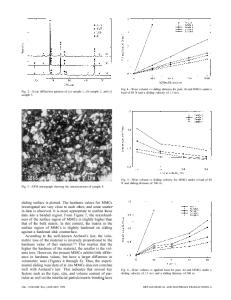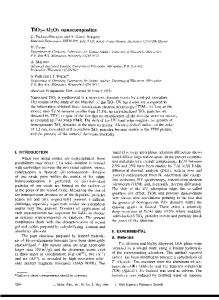In situ TEM Straining of Nanograined Al Films Strengthened with Al 2 O 3 Nanoparticles
- PDF / 470,732 Bytes
- 6 Pages / 612 x 792 pts (letter) Page_size
- 61 Downloads / 297 Views
1262-V01-04
In situ TEM Straining of Nanograined Al Films Strengthened with Al2O3 Nanoparticles K. Hattar1, B. G. Clark1, J. A. Knapp1, D. M. Follstaedt1, and I. M. Robertson2 Sandia National Laboratories, Physical, Chemical, & Nano Sciences Center, PO Box 5800 Albuquerque, NM 87185, U.S.A. 2 University of Illinois at Urbana-Champaign, Department of Materials Science and Engineering, 1304 W. Green Street, Urbana, IL 61801, U.S.A. 1
ABSTRACT Growing interest in nanomaterials has raised many questions regarding the operating mechanisms active during the deformation and failure of nanoscale materials. To address this, a simple, effective in situ TEM straining technique was developed that provides direct detailed observations of the active deformation mechanisms at a length scale relevant to most nanomaterials. The capabilities of this new straining structure are highlighted with initial results in pulsed laser deposited (PLD) Al-Al2O3 thin films of uniform thickness. The Al-Al2O3 system was chosen for investigation, as the grain size can be tailored via deposition and annealing conditions and the active mechanisms in the binary system can be compared to previous studies in PLD Ni and evaporated Al films. PLD Al-Al2O3 free-standing films of various oxide concentrations and different thermal histories were produced and characterized in terms of average grain and particle sizes. Preliminary in situ TEM straining experiments show intergranular failure for films with 5 vol% Al2O3. Further work is in progress to explore and understand the active deformation and failure mechanisms, as well as the dependence of mechanisms on processing routes. INTRODUCTION There has been significant interest in nanograined metals and their deformation and failure mechanisms for several decades. Over this time, the processing and mechanical testing of these nanograined structures have improved significantly. Many interesting properties have been reported and attributed to a variety of mechanisms [1, 2]. For example, Wang et al. has reported that with the proper control of rolling at liquid nitrogen temperature, followed by low temperature annealing, a metal that has both high strength and large ductility can be formed. This combination of properties is not typical of either nanograined or coarse grained metals [3]. In order to understand the active mechanisms that permit this unique combination of properties, detailed in situ TEM experiments must be done to investigate the effect of microstructural variables within nanograined films. The development of in situ TEM techniques for straining of free-standing thin films and simultaneous observations of the active deformation and failure mechanisms has progressed significantly over the last decade. A variety of in situ TEM straining structures used to apply mechanical load to nanostructured metals has been developed. Each of these structures provide benefits and limitations that should be considered when developing an in situ experiment to elucidate certain mechanisms [4, 5]. This study will empha
Data Loading...











